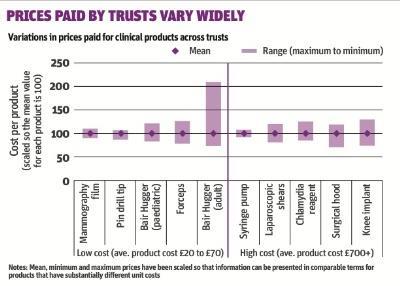Rotherham Foundation Trust has completed a year-long project to drive savings through strategic sourcing and by expanding the skills of the procurement team, writes Steph Holmes
With reduced budgets and a greater demand on patient services, NHS trusts are being asked to deliver services that meet increasing performance targets but for less money. This was the challenge facing our organisation and we, like every NHS organisation, are under pressure to make significant savings.

Together with the head of finance I recognised that to meet the challenge an effective procurement strategy to drive savings from all aspects of our non-pay spend would be needed. In order to rapidly achieve what we needed to, we decided some outside help was necessary and called in procurement consultancy Inverto to help.
Strategic sourcing
We had ambitious targets, setting ourselves a goal of savings of around £3m. However, driving these savings through to the balance sheet was only one of our objectives.
The second was the development of the team’s skills and knowledge, in order to ensure that the improvements we made were sustainable and trust staff are able to continue to drive further savings year on year.
There is a big difference between strategic sourcing and transactional procurement. Much procurement in the NHS is driven by compliance and simply putting a contract in place, but this is not going to lead to the best commercial outcome for any organisation.
‘One of the most significant challenges NHS organisations face is benchmarking both costs and current commercial performance’
The NHS is a powerful and significant purchaser and collaboration, aggregation and combined leverage all make sense, but one of the most significant challenges NHS organisations face is benchmarking both costs and current commercial performance so they know what the best price is.
During the first phase of the project we worked to identify precisely where the most significant savings could be made and to prioritise action. Twenty work streams were put in scope, based on categories of spend with a high value and where our benchmarking also indicated a high savings potential.
These were then prioritised into a programme of work based on three waves that we felt could be achieved with the resources available.
First wave
The first wave not only included the quick wins we had identified, but also work streams that we knew would take time to execute. A good example being medical and surgical consumables, which we knew would require a large-scale tender followed by an intensive product trialling and acceptance phase. Through a structured programme of strategic sourcing, a combined team of trust procurement and Inverto implemented methodologies have driven down prices and taken out cost.
By helping the organisation to understand its relationship with suppliers, there have been some very significant savings and these have been achieved across all areas of trust expenditure.
However, price can’t be the only deciding factor. In a clinical setting, quality and patient outcome must drive any purchasing decision. We have put in place a board of clinicians that is consulted on all procurement decisions. This has ensured stakeholder agreement to the new procurement process, which has been vital to putting in place new contracts.
Case study: orthopaedics expenditure
Collaborative working between clinical and non-clinical teams has been critical to the successful implementation of sustainable, long-term savings. Nowhere was this more evident than when clinical and non-clinical staff came together to deliver a 23 per cent saving, equivalent to more than £800,000 per annum.
This was achieved by conducting a large-scale review of how products are sourced, bought and managed within the orthopaedic department. Traditionally surgeons have a very high degree of supplier loyalty as their training is often with only certain supplier systems and products, making switching suppliers challenging.
‘A combined team of trust procurement and Inverto implemented methodologies have driven down prices and taken out cost’
When we started it was clear from discussions with key stakeholders that there was a limited understanding of the impact on cost per procedure through the way products were being selected and sourced. Our procurement team worked closely with the clinical director and the orthopaedic department to make savings by building strategic relationships with suppliers to leverage spend, benchmarking prices against national frameworks and improving stock management.
The project team embarked on a series of stakeholder meetings: firstly with the clinical director and then with the individual surgical teams to ensure they bought in to the process and align objectives.
A total cost analysis was completed that showed the cost per procedure, enabling the surgical teams to understand the impact of their clinical preferences on the trust. This led to a number of quick win opportunities as clinicians began to rationalise and standardise the number of products used.
Information sharing
Suppliers, both current and potential, were engaged early in the process, as part of a comprehensive supply market analysis. Information was shared by clinicians and procurement to understand the potential for product standardisation and rationalisation.
Based on this planning, the procurement team was able to define the precise business requirements of the trust and then prepare all necessary tender documents, issuing the tender to the market via the trust’s e-tendering system.
‘Execution of the tender showed that individual trusts can punch above their weight when good procurement is backed up with commitment to suppliers’
Once the bids were received and the initial evaluation completed the project team met with each orthopaedic team individually to consider the results. Given the work patterns of the surgeons these were held in the evening and were particularly well attended. It was testament to the buy-in of the clinical director and his surgical teams to the objectives of the process that so many surgeons were willing to attend after their theatre procedures had been completed.
Unlocking savings
Execution of the tender demonstrated exactly how competitive this category was and showed that individual trusts can punch above their weight when good procurement is backed up with commitment to suppliers.
What worked particularly well was that a joint team was able to exploit its collective clinical and commercial knowledge to unlock significant savings for the trust. The number of suppliers and items has been reduced and the surgical team now has a clear picture of the costs of the products it routinely uses and through the engagement with surgeons, why certain procurement decisions have been made. This makes implementation of the changes that are required manageable while improving clinical outcomes.
By adopting a total cost approach to our expenditure in the orthopaedic area the team has delivered an excellent saving that can be reinvested. This example of joint working is a powerful model we will use again to ensure it secures value for money in all areas of the trust’s spend.
Results
We have come to the end of our year-long project and I believe we have met our two objectives.
Across the 20 categories of spend, both clinical and non-clinical, the project has to date delivered more than £2m of cash savings. Non-clinical categories such as agency staff, cleaning consumables and telecoms yielded excellent results.
More challenging were the clinical categories, in the main due to need for strong clinical engagement and intensive product trialling. However, we have also achieved significant savings in orthopaedics, dressings, surgical instruments, gloves, intravenous and syringes as well as orthotics and hearing aids.
‘Procurement in the NHS is a complex beast at the mercy of a number of changeable factors at national level, at regional collaborative levels, in the organisation itself and, of course, in the supply market’
The key success has been working very closely with the hospital stakeholders such as theatre nurses, surgeons and clinicians. Firstly in determining and reflecting their needs to the supply market and then working together to implement these, ensuring the optimum combination of clinical preference and commercial benefit.
However, in terms of realising the benefits, implementation is everything – you can have the best commercial frameworks in place with suppliers but savings are only achieved if the hospital buys from them.
Future challenges
As well as savings, sustainability of capability has also been key. While we already had in place category managers, Inverto provided training for them to demonstrate some new ways of working and tools to best leverage our relationships with suppliers. This has further boosted our procurement team’s confidence and skills to have more robust conversations with suppliers and make the necessary changes.
This support also meant we could increase and supplement the number of buyers on the ground in order to make fast, effective savings. The outcome: significant savings and a procurement team ready to face the challenges ahead.
NHS organisations must get more strategic to deliver savings. Procurement in the NHS is a complex beast at the mercy of a number of changeable factors at national level, at regional collaborative levels, in the organisation itself and, of course, in the supply market.
With the publication of the Department of Health report NHS Procurement: Raising our Game and the new NHS standards of procurement, the advice from the DH is clear – for trusts; procurement teams on the ground must become significantly stronger, and I believe we have gone a long way at Rotherham Foundation Trust to achieving this.
Steph Holmes is head of procurement at Rotherham Foundation Trust























2 Readers' comments